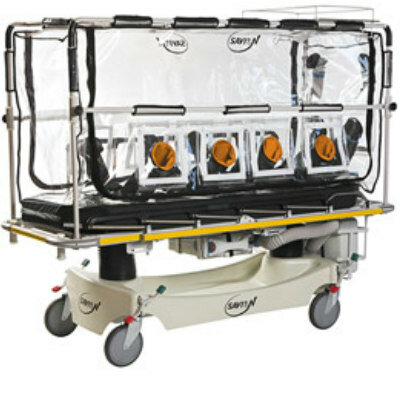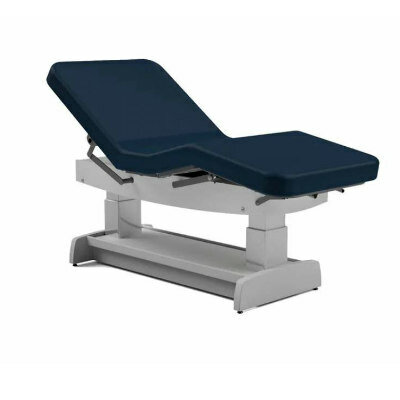Osmotic Bolus Injector Reduces Injection Frequency
|
By HospiMedica International staff writers Posted on 28 Jul 2021 |

Image: The Osmotic WBI allows self-administration of large and viscous drug doses (Photo courtesy of Subcuject)
A novel osmotic drive powers low-cost bolus injection technology that can be applied to a broad range of drugs.
The Subcuject (Hellebaek, Denmark) Osmotic Wearable Bolus Injector (WBI) is a low-cost, patient-friendly, prefilled bolus injector that utilizes forward osmosis technology to deliver three ml of a fluid drug of choice. In simplified terms, the osmotic drive module contains two chambers of liquid separated by a semipermeable membrane. Controlled addition of salt to one chamber draws in liquid from the other chamber, generating hydraulic/mechanical pressure that drives the plunger in the primary drug container.
Feature of the single use, disposable WBI device include invisible, automatic thin needle insertion and retraction; small size (76 mm) and low weight 55 grams); thin needles; and noiseless operation, as there are no electronics or batteries involved. To activate the Osmotic WBI, it is affixed to the skin, activated by a single button press, and discarded after use. Total injection time is between 245 and 349 seconds, depending on the viscosity of the drug and needle gauge. No assembly is required, and there are no settings to be adjusted.
“Subcuject has developed a purely mechanical wearable injector for single use, using forward osmosis as the drive mechanism and using a standard glass primary container. This achieves significant economic advantage, with the device cost expected to be in the range of a single-use autoinjector,” said Claus Schmidt Moeller, CTO of Subcuject. “As pressure needs to be built up before the plunger starts moving, there is a soft injection start for increased patient comfort and minimized risk of impact damage in the primary container.”
Osmosis is a spontaneous process, where water molecules cross a membrane in both directions without spending any external energy (Brownian movements). When an osmotic agent (such as salt) is dissolved in the water on one side of the membrane, each ion of a dissolved salt crystal attracts and binds several water molecules. The permeability of these hydrated ions through the membrane is much lower than for the free water molecules, and they stay on one side of the membrane due to a combination of their size and the complex hydrophilic/hydrophobic properties of the membrane. This results in spontaneous flow of water molecules from the freshwater side to the saltwater side of the membrane, building up pressure.
Related Links:
Subcuject
The Subcuject (Hellebaek, Denmark) Osmotic Wearable Bolus Injector (WBI) is a low-cost, patient-friendly, prefilled bolus injector that utilizes forward osmosis technology to deliver three ml of a fluid drug of choice. In simplified terms, the osmotic drive module contains two chambers of liquid separated by a semipermeable membrane. Controlled addition of salt to one chamber draws in liquid from the other chamber, generating hydraulic/mechanical pressure that drives the plunger in the primary drug container.
Feature of the single use, disposable WBI device include invisible, automatic thin needle insertion and retraction; small size (76 mm) and low weight 55 grams); thin needles; and noiseless operation, as there are no electronics or batteries involved. To activate the Osmotic WBI, it is affixed to the skin, activated by a single button press, and discarded after use. Total injection time is between 245 and 349 seconds, depending on the viscosity of the drug and needle gauge. No assembly is required, and there are no settings to be adjusted.
“Subcuject has developed a purely mechanical wearable injector for single use, using forward osmosis as the drive mechanism and using a standard glass primary container. This achieves significant economic advantage, with the device cost expected to be in the range of a single-use autoinjector,” said Claus Schmidt Moeller, CTO of Subcuject. “As pressure needs to be built up before the plunger starts moving, there is a soft injection start for increased patient comfort and minimized risk of impact damage in the primary container.”
Osmosis is a spontaneous process, where water molecules cross a membrane in both directions without spending any external energy (Brownian movements). When an osmotic agent (such as salt) is dissolved in the water on one side of the membrane, each ion of a dissolved salt crystal attracts and binds several water molecules. The permeability of these hydrated ions through the membrane is much lower than for the free water molecules, and they stay on one side of the membrane due to a combination of their size and the complex hydrophilic/hydrophobic properties of the membrane. This results in spontaneous flow of water molecules from the freshwater side to the saltwater side of the membrane, building up pressure.
Related Links:
Subcuject
Latest Patient Care News
- Surgical Capacity Optimization Solution Helps Hospitals Boost OR Utilization

- Game-Changing Innovation in Surgical Instrument Sterilization Significantly Improves OR Throughput
- Next Gen ICU Bed to Help Address Complex Critical Care Needs
- Groundbreaking AI-Powered UV-C Disinfection Technology Redefines Infection Control Landscape
- Clean Hospitals Can Reduce Antibiotic Resistance, Save Lives
- Smart Hospital Beds Improve Accuracy of Medical Diagnosis
- New Fast Endoscope Drying System Improves Productivity and Traceability
- World’s First Automated Endoscope Cleaner Fights Antimicrobial Resistance
- Portable High-Capacity Digital Stretcher Scales Provide Precision Weighing for Patients in ER
- Portable Clinical Scale with Remote Indicator Allows for Flexible Patient Weighing Use
- Innovative and Highly Customizable Medical Carts Offer Unlimited Configuration Possibilities
- Biomolecular Wound Healing Film Adheres to Sensitive Tissue and Releases Active Ingredients
- Wearable Health Tech Could Measure Gases Released From Skin to Monitor Metabolic Diseases
- Wearable Cardioverter Defibrillator System Protects Patients at Risk of Sudden Cardiac Arrest
- World's First AI-Ready Infrasound Stethoscope Listens to Bodily Sounds Not Audible to Human Ear
- POC Diagnostic Platform Offers Handheld, Instrument-Free PCR Testing for STIs
Channels
Artificial Intelligence
view channel
AI-Powered Algorithm to Revolutionize Detection of Atrial Fibrillation
Atrial fibrillation (AFib), a condition characterized by an irregular and often rapid heart rate, is linked to increased risks of stroke and heart failure. This is because the irregular heartbeat in AFib... Read more
AI Diagnostic Tool Accurately Detects Valvular Disorders Often Missed by Doctors
Doctors generally use stethoscopes to listen for the characteristic lub-dub sounds made by heart valves opening and closing. They also listen for less prominent sounds that indicate problems with these valves.... Read moreCritical Care
view channel
Deep-Learning Model Predicts Arrhythmia 30 Minutes before Onset
Atrial fibrillation, the most common type of cardiac arrhythmia worldwide, affected approximately 59 million people in 2019. Characterized by an irregular and often rapid heart rate, atrial fibrillation... Read more
Breakthrough Technology Combines Detection and Treatment of Nerve-Related Disorders in Single Procedure
The peripheral nervous system (PNS) serves as the communication network that links the brain and spinal cord to every other part of the body. It consists of two parts: the somatic nervous system, which... Read moreSurgical Techniques
view channel
Hydrogel-Based Miniaturized Electric Generators to Power Biomedical Devices
The development of engineered devices that can harvest and convert the mechanical motion of the human body into electricity is essential for powering bioelectronic devices. This mechanoelectrical energy... Read moreWearable Technology Monitors and Analyzes Surgeons' Posture during Long Surgical Procedures
The physical strain associated with the static postures maintained by neurosurgeons during long operations can lead to fatigue and musculoskeletal problems. An objective assessment of surgical ergonomics... Read more.jpg)
Custom 3D-Printed Orthopedic Implants Transform Joint Replacement Surgery
The evolving field of 3D printing is revolutionizing orthopedics, especially for individuals requiring joint replacement surgeries where traditional implants fail to provide a solution. Although most people... Read more
Cutting-Edge Imaging Platform Detects Residual Breast Cancer Missed During Lumpectomy Surgery
Breast cancer is becoming increasingly common, with statistics indicating that 1 in 8 women will develop the disease in their lifetime. Lumpectomy remains the predominant surgical intervention for treating... Read moreHealth IT
view channel
Machine Learning Model Improves Mortality Risk Prediction for Cardiac Surgery Patients
Machine learning algorithms have been deployed to create predictive models in various medical fields, with some demonstrating improved outcomes compared to their standard-of-care counterparts.... Read more
Strategic Collaboration to Develop and Integrate Generative AI into Healthcare
Top industry experts have underscored the immediate requirement for healthcare systems and hospitals to respond to severe cost and margin pressures. Close to half of U.S. hospitals ended 2022 in the red... Read more
AI-Enabled Operating Rooms Solution Helps Hospitals Maximize Utilization and Unlock Capacity
For healthcare organizations, optimizing operating room (OR) utilization during prime time hours is a complex challenge. Surgeons and clinics face difficulties in finding available slots for booking cases,... Read more
AI Predicts Pancreatic Cancer Three Years before Diagnosis from Patients’ Medical Records
Screening for common cancers like breast, cervix, and prostate cancer relies on relatively simple and highly effective techniques, such as mammograms, Pap smears, and blood tests. These methods have revolutionized... Read morePoint of Care
view channel
Critical Bleeding Management System to Help Hospitals Further Standardize Viscoelastic Testing
Surgical procedures are often accompanied by significant blood loss and the subsequent high likelihood of the need for allogeneic blood transfusions. These transfusions, while critical, are linked to various... Read more
Point of Care HIV Test Enables Early Infection Diagnosis for Infants
Early diagnosis and initiation of treatment are crucial for the survival of infants infected with HIV (human immunodeficiency virus). Without treatment, approximately 50% of infants who acquire HIV during... Read more
Whole Blood Rapid Test Aids Assessment of Concussion at Patient's Bedside
In the United States annually, approximately five million individuals seek emergency department care for traumatic brain injuries (TBIs), yet over half of those suspecting a concussion may never get it checked.... Read more
New Generation Glucose Hospital Meter System Ensures Accurate, Interference-Free and Safe Use
A new generation glucose hospital meter system now comes with several features that make hospital glucose testing easier and more secure while continuing to offer accuracy, freedom from interference, and... Read moreBusiness
view channel
Johnson & Johnson Acquires Cardiovascular Medical Device Company Shockwave Medical
Johnson & Johnson (New Brunswick, N.J., USA) and Shockwave Medical (Santa Clara, CA, USA) have entered into a definitive agreement under which Johnson & Johnson will acquire all of Shockwave’s... Read more
















